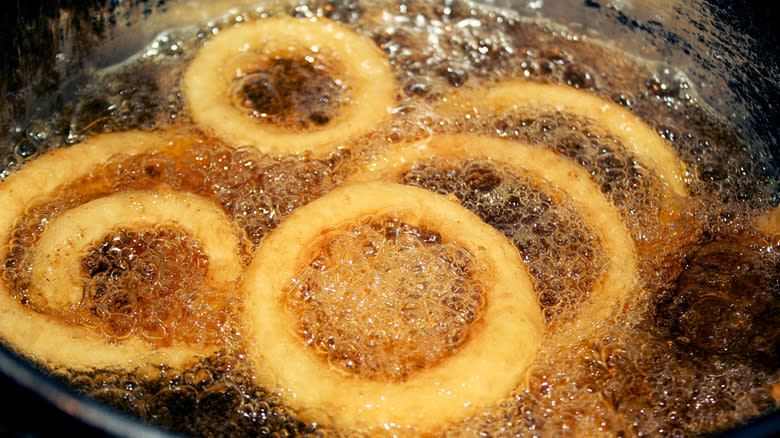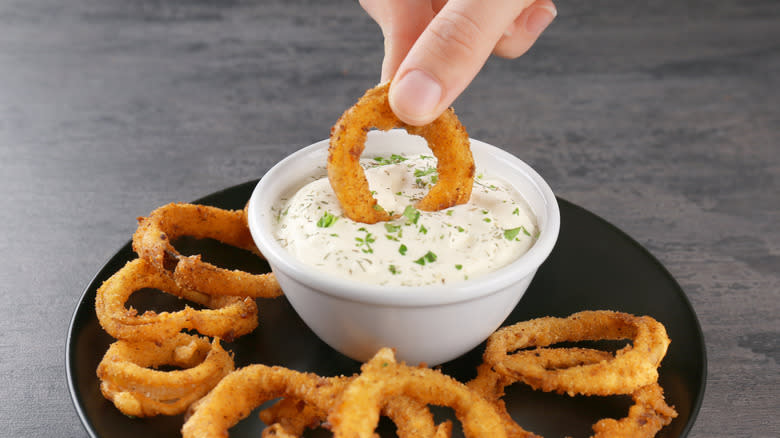Why Science Says Batter-Fried Onion Rings Reign Supreme

A staple on many an appetizer menu, onion rings are the perfect deep-fried treat. The muted taste of a cooked onion combined with a flaky crust and a hearty dipping sauce is certainly hard to beat. But whether you eat this savory snack at your local happy hour or make it in your kitchen, good onion rings require a crispy outer shell. Achieving this finish comes down to one thing: frying them in batter.
Before being dropped in a vat of hot oil, raw onion rings can be breaded or battered. Breaded rings are dredged in a dry mixture of flour and seasonings. Add a liquid -- like water, beer, or even eggs -- to that same blend, and you create a batter. Battered rings are coated in this goopy concoction before going into the fryer. Is there a serious difference between the two methods? You bet. If you're looking for the crispiest onion rings, science tells us that the moisture in batter-fried onion rings will create the ultimate crunchy texture.
Read more: The Best Grocery Store In Every State
Why Batter Is Superior

To understand the benefits of using a batter, it's essential to first grasp the basic science behind frying. As outlined in a paper published in The Journal of Food: Microbiology, Safety & Hygiene, exposure to extremely hot oil triggers the Maillard reaction, a chemical process in which amino acids are broken down. The byproducts of this reaction include pyrazines, furans, and aldehydes, which create the "rich and savory flavor profile" associated with fried foods.
Another byproduct of the Maillard reaction is dehydration. Frying oils are heated far beyond the boiling temperature of water. For example, onion rings are typically cooked in oil at 375 degrees Fahrenheit. When a piece of food is exposed to such high temperatures, its water content immediately begins to boil and evaporate. As the moisture in the food evaporates, the food dehydrates, and the remaining structure forms a crusty outer shell -- the crispy casing found on all your favorite fried foods.
Due to the different moisture levels, onion rings coated and fried in batter will have a crispier texture compared to rings that have only been breaded. Breading mixtures lack moisture, and when breaded rings are dropped into the fryer, the moisture in the onion itself immediately starts boiling. As a result, the onion becomes dehydrated and crispy. When battered rings enter the fryer, the heavy moisture in the batter begins to evaporate. The batter coating dehydrates and forms a crisp shell while the onion itself softens without actually frying.
Tips For Successful Onion Rings

To maximize the crunchiness of your rings, consider using a batter mixture that contains flavorful breadcrumbs. A study published in the journal Food Structure quantified "crispiness" and fried several samples using various breadcrumb sizes. The paper determined that as "breadcrumb coatings decrease," the result is generally "reduced crispness perception" in fried foods.
In a video published by Epicurious, a food scientist notes a few tricks to remember when preparing onion rings. To get a crispier outer shell, you can try using rice flour in your batter mix. Compared to wheat flour, rice flour can pack a bit of extra crunch. Plus, it's gluten-free. To keep the batter from falling off the onion, try adding a natural thickening agent to help, like xantham gum. The gum will improve the viscosity of the batter and help it adhere to slippery onions. To bring out the flavor of the onion itself, try browning the onions briefly before covering them in batter. The browning process will extract some of the sugars in the onion, which will add a layer of sweetness to the final product.
Read the original article on Daily Meal.

